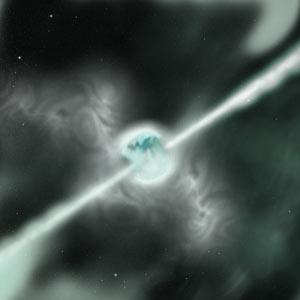Astronomers discover most dark gamma-ray bursts occur in normal galaxies
 Washington, June 9 : An international team of astronomers has found most dark gamma-ray bursts occur in normal galaxies detectable by large, ground-based optical telescopes.
Washington, June 9 : An international team of astronomers has found most dark gamma-ray bursts occur in normal galaxies detectable by large, ground-based optical telescopes.
Gamma-ray bursts are the universe''s biggest explosions, capable of producing so much light that ground-based telescopes easily detect it billions of light-years away.
Yet, for more than a decade, astronomers have puzzled over the nature of so-called dark bursts, which produce gamma rays and X-rays but little or no visible light.
They make up roughly half of the bursts detected by NASA''s Swift satellite since its 2004 launch.
Recently, at the American Astronomical Society meeting in Pasadena, California, an international team of astronomers reported surprising new insight into dark bursts.
The study finds that most occur in normal galaxies detectable by large, ground-based optical telescopes.
"One possible explanation for dark bursts was that they were occurring so far away their visible light was completely extinguished," said Joshua Bloom, associate professor of astronomy at the University of California (UC), Berkeley and the study''s senior author.
Thanks to the expansion of the universe and a thickening fog of hydrogen gas at increasing cosmic distances, astronomers see no visible light from objects more than about 12.9 billion light-years away.
Another possibility is that dark bursts were exploding in galaxies with unusually thick amounts of interstellar dust, which absorbed a burst''s light, but not its higher-energy radiation.
Using one of the world''s largest optical telescopes, the 10-meter Keck I in Hawaii, the team looked for unknown galaxies at the locations of 14 Swift-discovered dark bursts.
"For eleven of these bursts, we found a faint, normal galaxy," said Daniel Perley, the UC Berkeley graduate student who led the study.
Most gamma-ray bursts occur when massive stars run out of nuclear fuel. As their cores collapse into a black hole or neutron star, gas jets, driven by processes not fully understood, punch through the star and blast into space.
There, they strike gas previously shed by the star and heat it, which generates short-lived afterglows in many wavelengths, including visible light.
The study shows that dark bursts must be similar, except for the dusty patches in their host galaxies that obscure most of the light in their afterglows.
"Our study provides compelling evidence that a large fraction of star formation in the universe is hidden by dust in galaxies that do not appear otherwise dusty," Perley said.
The stars thought to explode as gamma-ray bursts live fast and die young. Dark bursts may represent stars that never drifted far from the dusty clouds that formed them. (ANI)